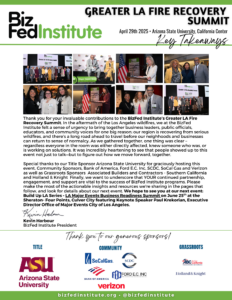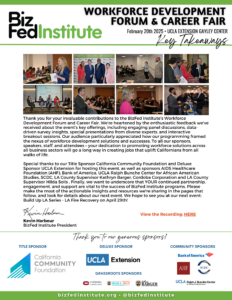An Overview of our 2nd Annual Energy Forum

The BizFed Institute’s 2nd Annual Energy Forum took place on Friday October 16, 2020, The Forum served as a platform for a meaningful discussion that explored the impact of COVID-19 and natural disasters on energy providers as well as energy consumers from targeted diverse industries. We knew going into the discussion that the past year has been difficult and we wanted to get a conversation that would help both energy providers and consumers identify solutions for a sustainable and reliable source of energy. The discussion gave us insight from the different perspectives of the panelists which allowed us to take a look at what their concerns were, the impacts on their respective organizations, the solutions that they were deploying and what they’d like to see happen in the future. We all are aware that there is a big push to focus on zero emissions, as well as the need to fortify and modify the energy infrastructure in order to give us viable and diverse energy options based on the needs of the public and private sector. The question is how do we get there in terms of the best path forward that includes keeping businesses, schools, and government open and homes energized as well as keeping transportation that supports our economy and everyday lives on the road.. As a result of the California wildfires there is also a big focus on safety so we can protect the environment and our communities where we live. The need for energy resilience and a hardened grid infrastructure is high on everyone’s priority list in order to reliably power our society.

Keynote Speaker takeaways: Liane Randolph, California Public Utilities CommissionerCommissioner Randolph started by speaking about how California needs to reach zero emissions by 2045. This is urgent because of the experience this past summer of enduring the worst heat wave in recent memory and the possibility of more extreme weather in coming years. Here are some ideas and actions she supports:>Working groups to find solutions and for each utility to engage in vulnerability assessments and then sharing the information on how to best prepare based on their respective findings. >The idea of figuring out how best to adapt to climate change and natural disasters by looking forward for the next 30 years with assessments in 3 year increments.>Implementing resiliency strategies and tactics like increasing grid capacity with “microgrids” on standby when the load is too heavy or when energy interruption is imminent. >No population segment should be left out and we all should work together toward a comprehensive solution.>Increasing capacity by 2023 by scaling up megawatts for available power.If we can work on and commit to these recommendations and solutions then we stand a chance of getting out in front of the climate change and natural disasters that are inevitable.

Panel 1 – Natural Disasters and COVID-19 Impact on Energy Providers:Southern California Gas Company – Joe Avila, Sr. Director of EnergyPolicy and StrategySoCal Gas has experience when it comes to natural disasters and its infrastructure is designed to anticipate these challenges. A telework strategy was implemented this year, while at the same time pivoting to “safe at work” strategies for those jobs that required time in the field. Their mantra has been “Reliability, Affordability & Resilience” and they believe in a balanced approach (for example, gas-fired power to enable solar & batteries) to energy and are laser focused on de-carbonization. Southern California Edison – Erica Bowman, Director, Resource and Environmental Planning and StrategyWhen COVID-19 hit, Edison adapted quickly by using telework and other innovative methods like aerial/drone inspections to continue to deliver essential services. Edison has been working to analyze, mitigate and adapt to wildfire risks, with record setting wildfires this year throughout the state, and other climate change risks like sea level rise threats to their infrastructure and heatwaves that will strain the grid. Edison also recognized the need for energy innovation and grid investments to achieve state climate goals in the coming years and decades, including energy storage, green hydrogen and low carbon fuels.
Western States Petroleum Association (WSPA) – Tiffany Roberts, Vice President, Regulatory AffairsWSPA, like all other businesses found 2020 to be a major challenge and found a new way of “thinking and doing” business. They felt the need for a commitment for transparency from regulatory agencies is important as well as evaluating the nature of how we work, healthcare and community engagement. WSPA highlights and emphasizes the need for a diverse energy grid mix to ensure resiliency and believes public policy with appropriate rules of engagement should complement energy choice and innovation. WPSA noted that by leapfrogging technology the state is leaving significant air quality reductions on the table. LADWP – Nancy Sutley, Chief Sustainability OfficerSince COVID-19 emerged, LADWP has had no virus transmission on the job. Construction has moved forward “business as usual” and has been supplemented with safety protocols. It’s important to note that there hasn’t been much of a strain on resources, particularly due to LAUSD delaying school openings and digital online customer service. LADWP believes long term strategic planning (20+yrs.) will be necessary to get to clean energy. They are collaborating with national organizations focused on resiliency and renewable energy that will help them with strategic planning and then to inform their customers what to expect. They are also focused on clean energy solutions and making sure that disadvantaged communities are not left out and are eligible for possible reduced costs through their energy conservation programs.

Panel 2:*Transportation Field >Foothill Transit: Kevin Parks McDonald – Deputy Executive Director Foothill Transit is proud of their forward thinking strategy of assembling a clean energy fleet of electric battery driven buses. They take their zero emission responsibility seriously and have invested heavily including the upcoming introduction of their first double decker electric battery powered buses. COVID-19 hit them hard, causing a reduction of ridership to 60% of their pre-COVID level. Needless to say this had a major impact on their 2020 revenue receipts and future projections. They are committed to offering safe physical distancing on their buses and support the idea of free ridership but must contend with and work out how to implement such an idea with the dual challenges of the loss of fare revenue to support operations along with the likelihood of higher costs due to increased service as a result of free rides. *Real Estate> US Green Buildings Council: Ben Stapleton – Executive DirectorAs a result of the long term onset of COVID-19, the very first thought was regarding “How the future of work would look like and how would the space be utilized?”. The other realization is that there’s a need for more green space. When realizing that buildings account for a huge carbon footprint, retrofitting will be a necessity to meet zero emission goals. Government and the community it serves will have to work together in setting building standards with industrial buildings needing much needed focus. The innovation of new technology will be a key factor and the ability to scale quickly will be a necessary component. The thought is to use this opportunity to work together for resilience and be equitable in the application. * Construction Field>Los Angeles/Orange County Building & Construction Trades Council: Ron Miller – Executive SecretaryLA/OC represents over 140,000 construction workers in LA/OC. This industry relies heavily on oil & gas to bend metal and fire cement boilers and glass. Without reliable forms of energy the industry would come to a halt and jobs lost. Electricity is key as well and must be reliable and sustainable. There is excitement about new technology in this industry and its emergence requires new workforce skills which means job security. The general opinion is that there’s a need for more transparency regarding how the energy rules are being written. The professionals in the industry need to be at the table to make sure the rules make sense and don’t bring industries to a halt by negatively impacting the economy as we work toward zero emissions. *Manufacturers/Business Field: >California Manufacturers & Technology Association: Lance Hastings – PresidentManufacturing is the driver of the economic engine and it takes energy to make things. Affordability and reliability is key! California currently pays more for energy while practicing better efficiency. With the regulatory pressure and hard push for zero emission, innovative technology will arise in order to save businesses that need to meet these goals. Climate impacts energy demand & supply everywhere and 15 year is a short time to get to zero emissions which is why we must collaborate. There is excitement around efficiency and provision to attract manufacturers back to California, but the question is “How long will it take?’.

*Takeaways & Closing Remarks>Climate Resolve: Jonathan Parfrey – Executive Director*We must pay attention to Commissioner Randolph’s concern regarding sufficient resources for next summer. There must be energy diversity to completely cover our energy requirements in CA.*LADWP stated that if it wasn’t for LAUSD shutting down there would’ve been an energy shortage.*COVID-19 caused new rules to be developed, but the challenge is understanding those rules and getting businesses to uniformly cooperate.*If we’re not pre-emptive, there will be costs for our inaction.

Keeping you informed,Â
Kevin Harbour
President, BizFed Institute



